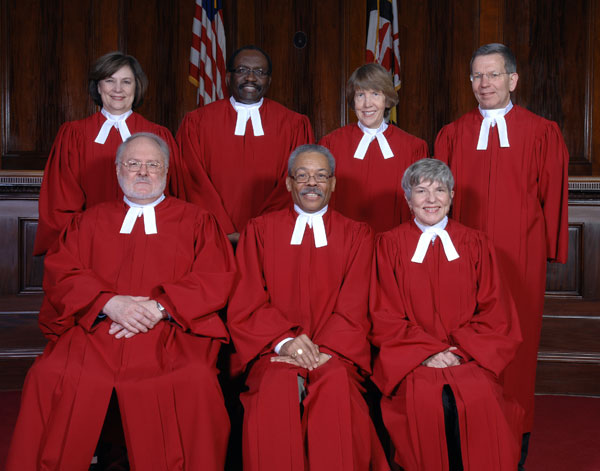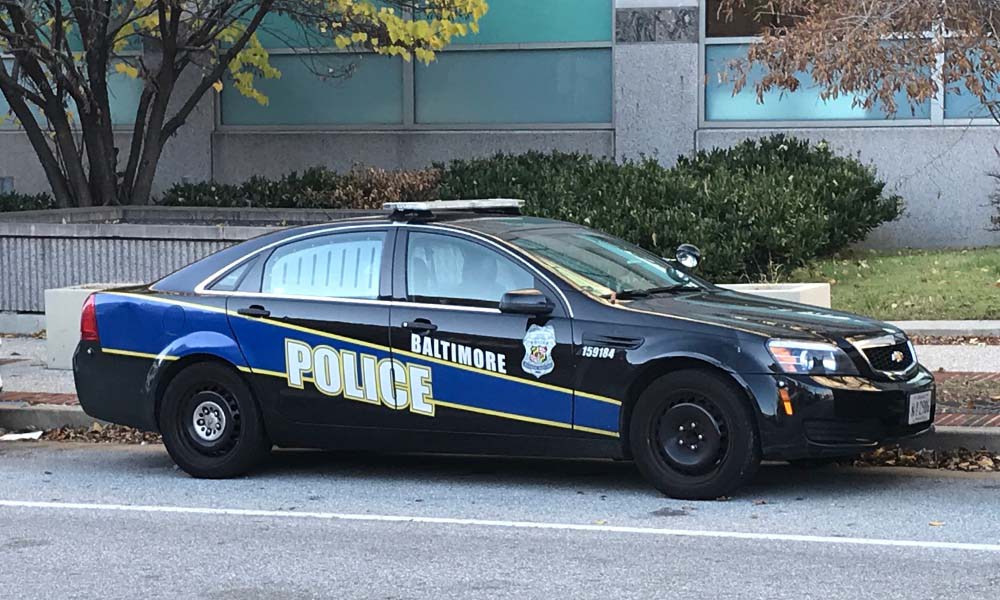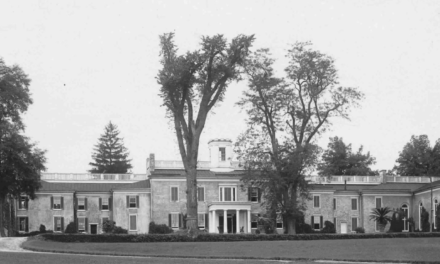By Sam Smith
Sam@MarylandReporter.com
In a Maryland Court of Appeals hearing Wednesday, opponents of Maryland’s newly redrawn state legislative map claimed that the state is violating a provision of the state constitution by crossing county boundaries for unnecessary, partisan purposes when creating senatorial districts
Although the reapportionment falls within the required 10% population deviation between the largest and smallest district, opponents say the map violates the “one person, one vote” provision in the U.S. Constitution because the map overpopulates districts in rural areas of the state, while urban and suburban districts are underpopulated.
“This, I believe, is all part of process,” said petitioner Jim Bouchat. “I do not believe that this institution will grant me my judgement. It is my intent to petition the United State Supreme Court, I believe it’s time for

Seated, from left: Judge Glenn T. Harrell Jr., Chief Judge Robert M. Bell, Judge Lynne A. Battaglia. Standing, from left: Judges Mary Ellen Barbera, Clayton Greene Jr., Sally D. Adkins, Robert N. McDonald
case law from the 1960s to be reviewed and potentially overturned to reflect the new context of our historical time.”
Opponents want ‘due regard’ used wisely
Article III, section 4 of the Maryland Constitution states, “Due regard shall be given to natural boundaries and the boundaries of political subdivisions.”
Opponents say the provision should only be used when jurisdictions do not have the population required to grant another senator, much like the western counties and Eastern Shore.
“When making a map, start with counties that can wholly contain a specific number of senators and once you do that look to the other counties and localities and see where crossing is needed,” said Jason Torchinsky, a Republican election law attorney representing the petition of Cynthia Houser.
“The position of the state is where you have to start from the corners and work in,” Torchinsky added.
Prince George’s County shares three districts with surrounding counties and Baltimore City shares one district with Baltimore County.
Kelley, Brochin upset with Baltimore County-City crossover
Three petitions against the map were represented at the hearing, with the most notable coming from Baltimore County Sens. Delores Kelley and Jim Brochin being represented by attorney Jonathan Shurburg. The two Democrats are upset because District 44 is now a crossover district with two-thirds coming from Baltimore County and a third from a southwestern slice of the city. However, that one move will cause a shift in the county’s legislating alignment effecting many of its districts. Baltimore City’s population warrants 5.05 legislative districts, yet with this map the city will potentially have six state senators.
“It takes the rest of the county and shoves it northward,” Shurburg said, “Sen. Brochin now is representing, instead of the Towson area, he is all the way up to the Pennsylvania border. Sen. Kelley, who previously represented an area right along the Baltimore City line, but wholly within the county, has been removed from that line completely and shoved northwestward into completely a new area.”
Special master recommends approval of map
In September, the court-assigned special master, retired appeals judge Alan Wilner, evaluated the claims in the petitions. He said in his report that there was insufficient proof to claim the plan passed by the governor and General Assembly served partisan purposes or discriminated regionally and racially. Wilner recommended that the court rule the map constitutional.
Although it is possible to create a map with less deviation, Assistant Attorney General Dan Friedman, general counsel to the legislature, reminded the judges that the map was not violating any laws as it was meeting its 10% deviation rate.
“As you have done in many cases in the past, you have left that difficult and challenging question unanswered because nothing forces you to answer it. That’s this case,” Friedman said. “There is nothing here that comes close to establishing a case that would overcome the presumption of validity that would attach to a map that is within 10 percent.”
In response to a question from Judge Lynne Battaglia, who asked what is unconstitutional about the map, Torchinsky said: “When the state has before it four jurisdictions that could wholly contain senate districts without crossing into any other jurisdiction, and the state simply ignores that and says ‘welp, since we need to cross we can cross anywhere we want.’ You get beyond what can be constitutional. Due regard means that you should keep it whole.”
State builds on 2002 map
In 2002, the state legislative districts were redrawn by the Court of Appeals, which attempted to draw a politically unbiased map. Friedman said the state took the map the court passed in 2002, and adjusted it to fit the current demographics of the state. The new map includes fewer boundary crossings (13), fewer deviations and more African-American majority districts.
“If [the Maryland Court of Appeals] map was constitutional, the state made the map better in all of those scores,” Friedman said. “How can the petitioners succeed in the claim of suggesting that we intended to make it worse?”
Three judges “retained” by voters
In a little noticed aspect of Tuesday’s election, voters decided to continue in office three of the seven judges on the Court of Appeals, including Chief Judge Robert Bell. After their appointment by the governor and every 10 years after, voters from the “circuit” they represent get to say whether the judges on Maryland’s highest court should continue to serve. This is called a “retention” election.
Voters know little about the appeals judges and unlike Circuit Court judges who can be challenged and must run in partisan primaries, the appeals judges do not campaign. So fewer voters cast their ballot for the judges, but more than 84% voted to keep them on the bench. In addition to Bell from Baltimore City, voters in Howard and five western counties voted to retain Judge Lynne Battaglia; and voters in Baltimore and Harford counties voted to retain Judge Robert McDonald, who was appointed in December 2011.
Bell is slated to retire in July when he reaches the mandatory retirement age of 70.








Upsetting the powers that be in Annapolis has its consequences that these protestors will soon find out. One must be loyal to the party, forget the people you are supposed to serve. That’s the “New” Maryland way!